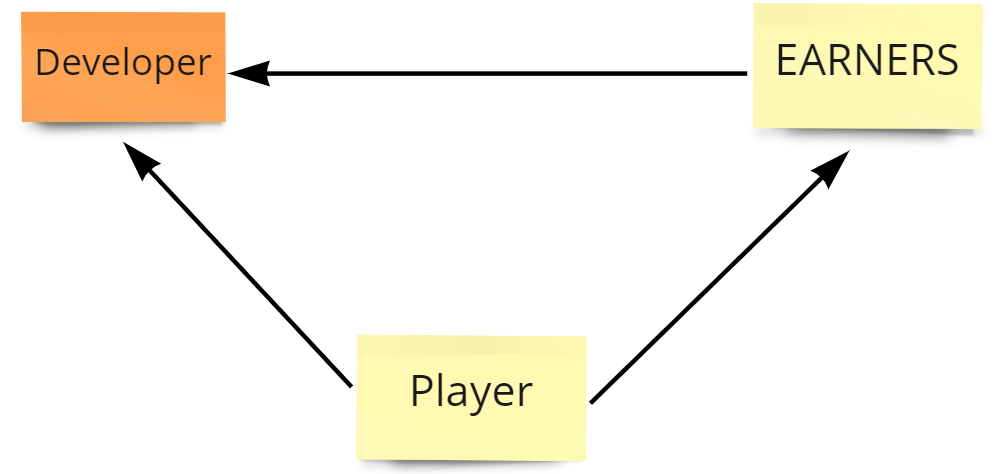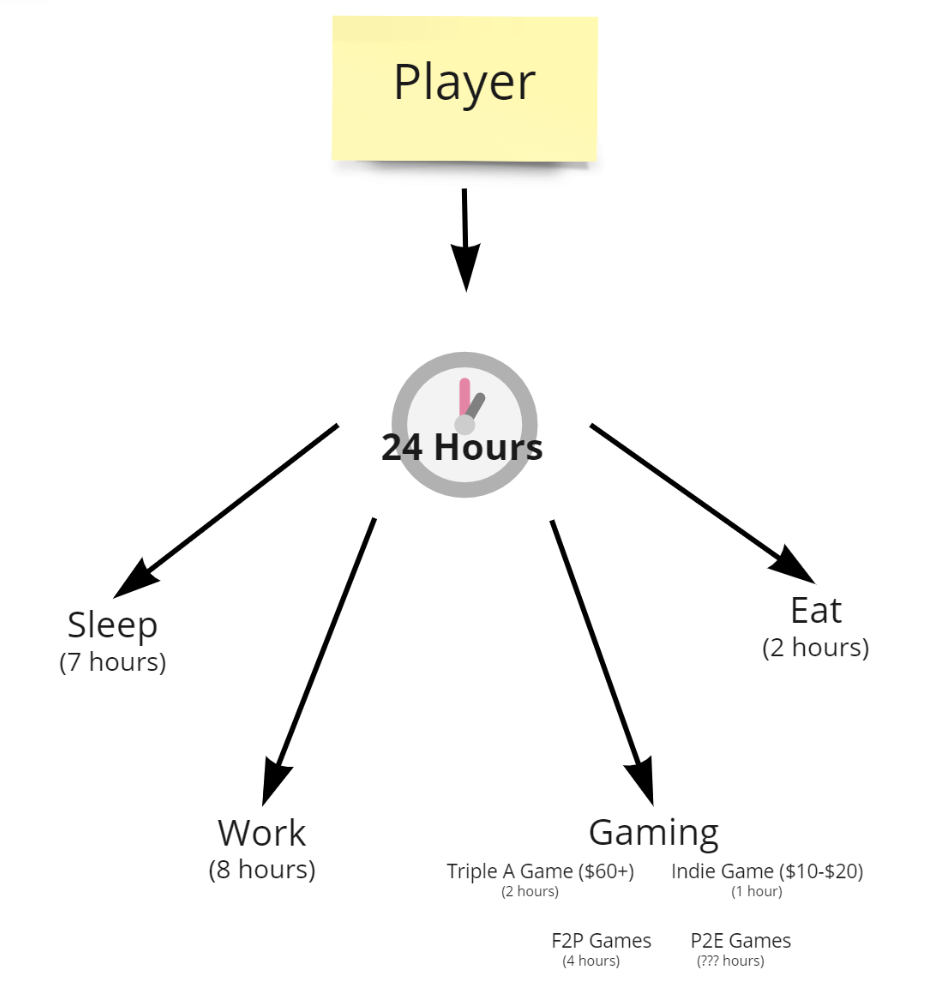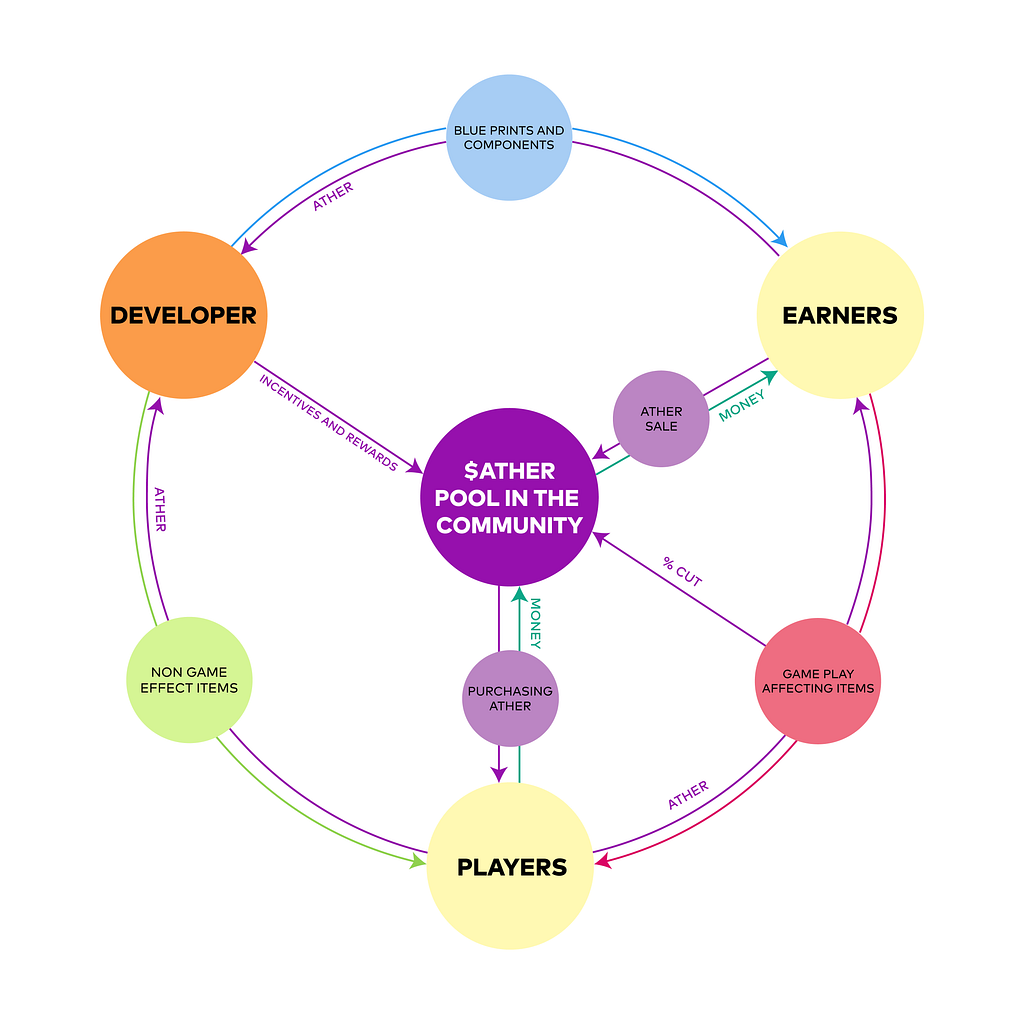SIPHER’s Three-Party Economy (Part 2)
Following up on Part 1 of the SIPHER Economy Article Series, we present and discuss SIPHER’s planned approach to a Three-Party Economy.
Note: The original publication date of this article was February 23, 2022.

Play AND Earn: SIPHER’s Vision
The takeaway from the previous article was: EARNER ONLY ECONOMIES DO NOT WORK
If this is the case, then the logical solution for any P2E game to succeed would be to focus on the PLAYERS as a significant portion of our ecosystem.
What is defined as a “PLAYER”?
A PLAYER is someone who derives entertainment from the game. Typically, they are willing to pay to maximize their personal enjoyment of this game.
The Importance of the PLAYERS in a Play & Earn Model
A strong and vibrant player-base — that enjoys the game and is willing to play the game at a monetary deficit in exchange for enjoyment — is a MANDATORY REQUIREMENT for a thriving P2E game that can sustain and benefit EARNERS over a long period of time. As previously mentioned, economies that primarily rely on earners are destined to fail.
Thus obviously, as all of you already know, our top priority in SIPHER is to create a fun and enjoyable game. This was a no-brainer, to begin with. However, there are other avenues that we can implement to establish a large player-base and onboard players into our game.
- Compete with Traditional Gaming
Thinking that a P2E game is separate and that it does not compete with traditional gaming due to having a “unique attraction” will lead to the death of the game. The truth is that we have to compete for the PLAYERS’ time and money, just like every other game in the market, regardless of whether or not they’re an NFT game. Each player only has 24 hours in a day, and they can only allocate a certain amount to their gaming hobby.
 Example of the daily life of an adult gamer (that has a job
Example of the daily life of an adult gamer (that has a job  )
)This means that, as a P2E game, we are competing with AAA games that are priced at around $60-$70, competing with some amazing indie games that are being priced in at around $10-$20, and of course, competing with many Free-2-Play (F2P) games that are in the PC and mobile markets.
2. Long Term Value Extraction, Instead of Upfront Extraction
Regardless of how good the game is, if the price of entry is $300+, it would be functionally impossible to build a thriving player-base. This game would now be competing with traditional gaming for about 3x-4x the price, and the quality is not necessarily going to compare with that of a Triple-A game.
We have to realize that, as it currently stands, conventional gamers are very resistant to the concept of NFT gaming. We could also argue that many traditional gamers might even think of NFTs as a scam, and do not yet understand the benefits of true ownership or being able to resell their assets after deciding not to play anymore.
When there’s such a strong negative association and lack of understanding about NFTs, and the game’s entry-point price is anything over $60, it will be very difficult to sell (to the traditional gamer), unless you are selling to someone who expects to make money (AKA EARNERS).
Once again: “EARNER ONLY ECONOMIES DO NOT WORK”
Thus we must attract the PLAYER to play our game, and extract value in the long term.
Think about CSGO, League of Legends, Hearthstone, Legends of Rune Terra, and many more.
We’re sure that there are many examples of people spending hundreds, if not thousands, of dollars on these games. As you can see, these examples show that players do not necessarily spend all their money in one instance — rather, the total amount of money spent is broken down into many smaller transactions, typically spanning months or years. Players most likely will not want to spend $300 to buy a game, but playing a game and spending $300 in microtransaction over months is an entirely different situation.
 Example illustration of the purchasing decision process of a traditional gamer
Example illustration of the purchasing decision process of a traditional gamerThis type of model is what we MUST implement in order to be successful and create long-term value.
2a: The SIPHER Market Place
To facilitate this long-term value extraction, SIPHER will incorporate its own marketplace within the game, giving a direct path for SIPHER gamers to purchase gear, consumables, etc. direct from their fellow learners.
This marketplace will serve two main purposes.
a) It keeps the SIPHER experience completely in-game, the players do not need to exit their game if they want to buy an in-game item.
b) It allows the Earners to closely monitor the market, seeing where the opportunities to make a profit are, and allows our earners and players to keep track of a VERY diverse market.
c) It gives the ability for EARNERs to essentially sell MTX to the player base, if someone wants to buy a stamina refill potion, they go on to the marketplace to buy it from an Earner, so on and so forth.
As SIPHER continues to update the game moving forward, there will be a constantly changing meta of weapons, characters, and armor, that facilitates trading and re-optimization of builds, this creates a demand that is always dynamic, and always present, allowing Earners to fill in the voids that they notice in the market.
PS: Of course, this marketplace will exist outside of the game also, look forward to an update from that from our Market Place team in the coming months.
3. Bridge NFTs to the general gaming population.
This is something that mainly applies to the P2E and NFT space. Mass adoption of the concept of NFTs, its interaction with gaming, and its benefits such as true ownership of in-game assets, will be the biggest step for the success of NFT gaming.
The benefits of NFTs in the video game space must be acknowledged by traditional gamers. We believe that this will happen eventually, but SIPHER plans to take action and execute marketing efforts to ensure that the benefits of NFTs are communicated and explained to traditional gamers. For those that don’t believe in it or need more time to accept these benefits, the game should still be there for them to experience.
With that said, this three-party economy (EARNER, PLAYER, DEVELOPER) is still quite complex.
Let’s break down the relationship between each entity, and how that wraps up into a functioning economy.
SIPHER’s HYBRID monetization
HOW DEVELOPERS AND EARNERS INTERACT IN THE ECONOMY
Adding EARNERS into the equation, we now have two entities looking to profit from the players. How do we go about sustaining an economy that is suitable for both entities without them cannibalizing each other?
Developers and Earners should NEVER be in direct competition
This is fairly straightforward and makes sense from a logical standpoint: if two entities want to exist in the same market and not adversely affect each other, they simply should not compete. In an ideal scenario, the Developer would not sell anything that the Earner sells, and they would only monetize a small percentage of the transaction between the Earner and the Player.
We can see a sub-optimal example of this with Valve’s CSGO.
Valve sells loot boxes, which any person can buy. If someone opens a loot box and luckily obtains a rare skin for a gun, this person can now sell this rare skin for profit on the Steam Marketplace (of which Valve receives a percentage of the transaction) or on a third party market (in which Valve receives no cut).
In this example, you can see that Valve is NOT directly selling that gun’s skin. This means that they are not competing with the player-base on the sale, but in essence, they are still the suppliers of that gun’s skin (via the loot box).
SIPHER’s future market (not necessarily a “Marketplace”) will have a much more complex model that is similar to this. Users will be able to craft various weapons and gear, and then they could sell to the PLAYERS who want to obtain a boost or want to spend less time grinding.
However, this does not mean that we can let everyone dictate the market freely, and there must be some checks and balanced systems in place to maintain stability for both earners and players alike.
Developers should influence the supply of items that Earners are selling
This will be further explained in the upcoming third article of our series. We will explain how SIPHER plans to do this, but we mention this now as it is a necessary step to ensure that our game has a stable and healthy economy and that there is no extreme price volatility for players and earners alike.
Earners will acquire components and blueprints from the Developer
The reason for this is simple, Earners are here to make money. Therefore, any time or money invested into this game is an opportunity to maximize their earnings down the line.
The answer that makes sense to fill this void is to have Earners craft components and blueprints. Some examples include, but are not limited to:
In-game Components:
- Vessel Cores
- Raw Materials for upgrading/crafting gear
Gear Blueprints:
- Chest Blueprints
- Helmet Blueprints
- Weapon Blueprints
- Spaceship Blueprints
Consumable Recipes:
- Stamina Refills
- Health Refills
- Shield Refills
This will allow the EARNERS to build and turn a profit, as this would be a one-off fee so they can start their production and selling process.
This system will also allow for Earners to specialize in niches (or sub-markets) within the overall market. For instance, they could focus their production efforts on certain items in demand, such as early-game gear, stamina refill recipes, etc. As you can see, demand is expanded into multiple items, which means that there are more opportunities for the Earners, and there are fewer chances of ending up with a market that has excess supply, as long as the system is well-balanced.

DEVELOPER AND PLAYER Relationship
PC Monetization or Mobile Monetization?
The Developer and Player relationship is nothing new, the only decision to make here is which method of monetization to lean towards.
At this point in time, SIPHER (as the Developer) is planning to mainly monetize non-gameplay affecting items.
The reason for this is simple: establish a clear division of products for Players in the market. If they want cosmetic flairs such as skins for their playable characters or gear, then they would directly purchase these from SIPHER (Developer). On the other hand, if Players want to acquire game-play affecting items, such as those that can fast-track their gameplay or make their character stronger, then they would need to obtain these from their fellow gamers (Earners).
As such, SIPHER could potentially monetize the following aspects:
1- Cosmetics such as:
- Skins
- Portraits
- Icons
- Emotes
- Titles
2- Battle-passes
3- In-game currency
4- Loot Boxes
Note that in all aspects mentioned above, SIPHER does not directly compete with the economy’s EARNERS.
EARNER AND PLAYER Relationship
We finally arrive at the most important relationship, Earners and Players
The relationship between EARNERS and PLAYERS is the core of the P2E mechanic. People who play the game now want to turn a profit, and their profit comes from those that are new to the game, or those who would like to optimize their end game experience.
Anybody can be an EARNER and anybody can be a PLAYER
It is important to note that EARNER and PLAYER are not mutually exclusive. It is very possible for someone to bounce between being one of the two, whenever you play for fun or spend money to further your enjoyment of the game you are a Player. On the other hand, when you decide to sell one of your items, or you craft an item to sell, you are an Earner.
The Earner Economy
As previously discussed, EARNERS will be the primary supply of gameplay affecting items, such as Gear (Armor, Weapons, Trinkets, Spaceships), Consumables (Stamina Refills, Health Refills, Shield Refills), and High Tier Clones.
Given that being a Player or Earner is not mutually exclusive, anyone can create “gameplay affecting items” and then sell them for profit. This also helps us create a game that does not feel like a cash grab to casual players, as all of these items are purchased from their fellow gamers.
Additionally, this type of economy provides a clear source of revenue on which EARNERS can capitalize, and also creates a multitude of avenues of earning rather than just “trade currency for money”. As a result, a more dynamic market is created, with Earners occupying various niches. The most successful earners will be those that figure out the most efficient methods of crafting and obtaining their products, and those who have accurate market timing.
Community Bootstrapping
This system also allows for communities in SIPHER to bootstrap their new members. For instance, imagine members in a community providing other new members with upgraded weapons and armor so that they can level up faster and further boost themselves in the leaderboard rankings.
As such, everything along a Player’s journey, beginning with the initial character and ending with end-game top-tier legendary gear and armor, is self-contained and can be provided for by the community.

PUTTING IT ALL TOGETHER

Putting it all together, we have this circle that represents the connections between the three entities that compose our market.
The Player will buy game-affecting items from Earners, who have produced those items by sourcing blueprints from the Developer. At the same time, the Players can buy cosmetics directly from the Developer.
In Summary
- Blueprints and Components: Sold from Developers to Earners
- Non Game Effect Items: Sold from Developers to Players
- Game Play Affecting Items: Sold from Earners to Players
These are all of them monetization tracks within the game, and all transactions will fall under one of these three tracks.
Please note that these tracks aren’t set in stone. For instance, there could be a future legendary skin that can only be obtained by crafting it; so the only way to obtain it is by crafting yourself or buying it from another Player / Earner. Or perhaps you got lucky with a legendary skin through a loot box, and you can now sell this skin to other Players**.
Hopefully, this provides some insight into what the future of the SIPHER Economy will look like, and how it will be a much more vibrant and diverse economy than most current P2E games due to the sheer number of possible revenue sources.
The final article of the series (Part 3 of the series) will focus on how we control a virtual market, providing stability and safety to the earners in our economy.
You can read it here:
SIPHER’s Plan for a Sustainable Economy (Part 3)
Sipher Website: https://sipher.xyz
Sipher Links: https://linktr.ee/sipherxyz
We are actively hiring! If you ♥ gaming and making great games, Join us at Sipher: https://careers.sipher.xyz/
SIPHER’s Three-Party Economy (Part 2) was originally published in SIPHER on Medium, where people are continuing the conversation by highlighting and responding to this story.



0 Comments
Recommended Comments
There are no comments to display.